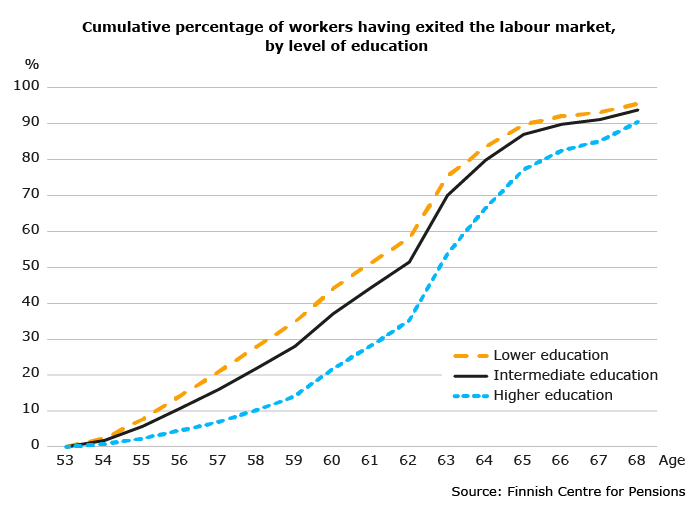Low-skilled older workers and early exit from the labour market: It’s not just who you are and where you work, but also whom you work with
In Finland, like in most other advanced industrialised countries, low-skilled older workers are at a higher risk of early exit from the labour market than their higher-educated peers. To extend these workers’ working lives, relying on their own responsibility or implementing more government policies alone will not be enough: the help of employers is needed.
Why do low-skilled workers exit earlier?
Studies on retirement and labour market exit like to point at individual factors related to such risks. First, low-skilled workers often have poorer health, while their health problems tend to accumulate across the life course. Second, low-skilled workers tend to work in jobs with poorer working conditions, which may not only make working in those jobs less attractive but can also reinforce health problems. Third, older workers with low levels of human capital are less in demand in the labour market. Finally, lower skills usually lead to lower pay, making retirement on a decent and steady income from pensions a relatively attractive alternative to work.
In our study recently published in the journal Work, Aging and Retirement, we used large administrative data to follow workers in Finnish private sector companies during the years 1995-2015. We analysed the risks of permanently leaving employment through retirement, unemployment, disability or other inactivity between the ages 53 and 68.
In our findings, low-educated older workers (i.e., those with no formal degree or only lower secondary education) are at a higher risk of early labour market exit than their higher-educated counterparts. The Figure below show the cumulative percentages of the study population that have exited the labour market at each age, differentiated by level of education. Lower-educated workers were especially more likely than others to exit before 63 (i.e., the lower boundary of the flexible retirement age in the earnings-related pensions system). By the age of 62, 58% of the lower educated had exited the labour market, compared with only 35% among the higher educated.
Firm characteristics, workforce composition and labour market exit
Our study focused on the role that employers and firms play in the retention or exit of their ageing staff. Employers make decisions about hiring and firing. In addition, they can use human resource management (HRM) to prevent that their older workers exit prematurely. Age-based HRM can include adjustments in ergonomics, tasks or work schedules to accommodate an ageing staff. Training and developing can be used to keep an ageing workforce’s skills relevant and up to date. However, we still know relatively little about which firms are more successful in using such measures to retain their older workers.
Besides controlling for a set of individual characteristics, we analysed the impact of the characteristics of the firms where older workers are employed. At the firm level we were especially interested in the composition of the workforce. For each company we calculated various measures for the age, education and wage structures of its entire staff.
We find that in companies that have younger and better educated staff, workers tend to exit later. Also, workforces that have more diverse age and skill structures reduce the risk of early exit. Finally, working lives are longer in companies where wages tend to rise with age. This is a surprising finding as it is usually assumed that seniority-based wages lead to incentives for employers to push out older workers because their wages tend to exceed their productivity.
What might be behind these findings is that companies with a higher educated and more diverse staff will invest more in measures to accommodate and develop their older workers. Firms want to keep these older workers because they are human resources that are valuable. Senior-based wages can be a part of this retention package: by offering promotion trajectories and relating salary levels to tenure, older workers are more likely to stay.
Good or bad news for low-skilled older workers?
The good news of these findings for low-skilled older workers is that they can benefit from a firm’s HRM practices if they work in dynamic firms with better educated, younger and more diverse co-workers. However, the first bad news is what economists call ‘assortative matching’: the more productive workers end up working for the more productive companies. This means that low-skilled older workers are more likely end up working along with other low-skilled older workers in companies that are less likely to invest in age-based HRM.
The second bad news is that, even if low-skilled older workers are employed at the more productive firms with better HRM policies, they are less likely to benefit from such policies. Earlier studies have shown that age-based HRM often is implemented on an ad hoc basis and is applied primarily to the older workers the employer wants to keep (Wainwright et al., 2018). HRM has also been found to be little effective in the changing retirement plans of low-skilled workers (Hennekam & Herrbach, 2013). Moreover, seniority wages, if applied to all staff, can be disadvantageous for low-skilled older workers: it makes them relatively more ‘expensive’ for the employer compared to their presumably more productive younger and higher-skilled colleagues (Frimmel et al., 2018).
Finland’s population is ageing rapidly and the pressure on employers to keep all older workers in the labour force will increase in coming years. This requires changes in attitudes towards older workers and concrete investments in age-friendly workplaces. Education, training and investments in workers’ skills across the life course is a crucial prerequisite for possibilities to extend working lives. Whereas Finland performs well on various indicators of lifelong learning, a recent OECD (2019) report showed that it belongs to the bottom performers in terms of coverage of adult learning systems. The report indicates that some of the largest gaps in training participation are between lower- and higher-skilled workers, the age groups 25-54 and 55+, and between lower- and higher-wage earners. Here lies a task primarily for policy-makers and employers, to make sure these gaps are closed.

References:
Frimmel, W., Horvath, T., Schnelzenberger, M. & Winter-Ebmer, R. (2018). Seniority wages and the role of firms in retirement. Journal of Public Economics, 164, 19–32.
Hennekam, S. & Herrbach, O. (2013). HRM practices and low occupational status older workers. Employee Relations, 35, 339–355.
OECD (2019). Getting Skills Right: Future-Ready Adult Learning Systems. Paris: OECD Publishing.
Riekhoff, A., Järnefelt, N. & Laaksonen, M. (2019). Workforce composition and the risk of labor market exit among older workers in Finnish companies, Work, Aging and Retirement.
Wainwright, D. et al. (2018). Extending working life and the management of change. Is the workplace ready for the ageing worker? Ageing & Society, 39, 2397–2419.
